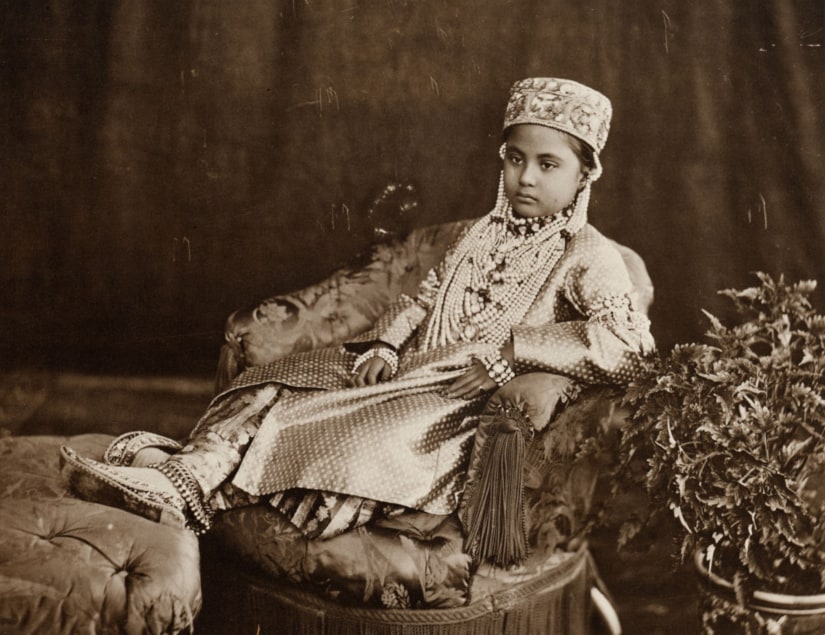Hyderabad of the Nizams: Documentation of diplomatic relations
Photography first came to India in the mid-19th century, when British administrators brought their cameras to the country to document the landscape, historical monuments and people. As early as the 1850s, photographic societies were formed in three presidencies: Bombay, Madras and Calcutta. The art form also emerged in the richest cities and courts. “Here, Hyderabad had a double advantage,” says historian and curator Deepthi Sasidharan.
The Asaf Jahi dynasty and its Nizams, their etiquette and famed jewels – and their photographs — were the subject of a recent lecture by Sasidharan. Apart from historical texts and exhibits in museums, one can learn about the opulence of their courts and the fashion of the time through the photographs taken of this family. “Royal portraits were important, they were considered aspirational must-haves, and symbolic gifts too,” Deepthi says.
Left to right: Imam Jung, Narendar Pesckar, Salar Jung I, HH Nizam Mir Mehboob Ali Khan, Nawab Rasheeduddin Khan Amir e Kabir III, Bashir-Ud-Dowla Bahadur (Nawab Sir Asman Jah Bahadur), Sir Vicar-Ul-Umra Bahadur II. Wikimedia Commons
Since the advent of photography, it was regular for wealthy royal families to get pictures made, she notes. Photographs had a changing role in the palace. Once members of royalty realised they could capture an ancestor’s likeness through photographs, they put them to many uses. “The first foray was typically one of curiosity, because the camera was a fabulous invention. It marked a sudden shift from painting… The faces of royalty appeared on dinner sets, they were on jewelry, on watches. They were also embroidered onto clothes,” Deepthi says. In Hyderabad, pictures were enlarged onto large canvases and displayed in palaces.
The photos of the Nizams were taken using typical box cameras, where exposure times were as long as one minute. The result is that the subjects had to pose in a manner that was stiff and still, says Deepthi, who is the co-author of the book Treasures of the Deccan: Jewels of the Nizams. “The photographers were largely Indian… Kings would also be photographed by foreign photographers who accompanied dignitaries. There was Raja Deendayal, Vernon and Co, and a variety of other photography firms,” she says.
The sixth Nizam Mir Mahbub Ali Khan with the Grand Duke Alexander of Russia (on the Nizam’s left), at Chowmahalla Palace. Wikimedia Commons
The Nizam was considered the premier princely ruler by the British and was regularly visited by officials from other countries. One photograph depicts the sixth Nizam Mir Mahbub Ali Khan sitting with the Grand Dukes of Russia after a cheetah hunt, another taken in 1892 features Prince Damrong Rajanubhab of Thailand after a shikar. Yet another captures the Duke and Duchess of Connaught admiring the sixth Nizam’s jewels, which were put out on display. “Getting a picture made when dignitaries visited one’s court became a convention,” Deepthi explains.
The collection of photographs taken of the Nizams include a number of family portraits. In one photograph of the seventh Nizam Mir Osman Ali Khan, he is pictured with his five principal wives and children. Many of these photographs do not strictly follow convention, especially the ones that feature children. “There is a photograph of a young prince and his sister, captured when she just broke into tears. The brother looked completely zapped at his sister’s expression. There also exist less formal photographs where the royals aren’t wearing jewels, where they’re horse-riding. You see softer aspects of their behaviour – a certain playfulness. Pictures of children pulling their father’s coats, tugging at their hair…,” she explains.
Often, original photographs were modified for use in future contexts, because of the paucity of pictures. In one instance, a Nizam’s photograph taken in childhood was altered when he grew older; the design of his sword underwent a change, the clothes were modified to reflect a change in fashion, and the Char Minar was painted in the background. “This addition of the Char Minar was significant – it showed that a Sunni emperor was embracing Shia culture,” Deepthi notes.
The photographs of this royal family are a record of their sartorial choices. “The traditional costume of the women was a loose kurti and trousers, with a ‘khada dupatta’ – a five metre-long cloth with an identical border on both sides,” she explains. Banarsi brocade and muslin were among the fabrics worn. In one photograph of Lady Jahandar-un-nisa, one observes the kind of costume that the famed 18th-century Hyderabadi courtesan Mah Laqa Bai wore, indicating how long styles and couture traditions endured in the city.
Photographs like the ones in this collection are vital visual history and help fill gaps in existing scholarship, says Deepthi, if one has the patience to look at them and glean the information they present. For example, they allow us to learn the sequence in which Hyderabadi royalty wore the several jewels they owned. This is crucial, if you consider the sheer number of jewelry pieces that existed: The women wore seven types of earrings and more than two necklaces. “Early photographic processes produced images that were sometimes so clear that one can notice all the details in present times… These pictures complete the circle of vocabulary used by jewelers, and pieces in the collection,” she says.
Deepthi Sasidharan delivered a lecture titled ‘Hyderabad of the Nizams: Visual splendour through 19th century photographs‘ at the Dr. Bhau Daji Lad Mumbai City Museum, Mumbai Source: https://www.firstpost.com/living/in-the-photographs-of-hyderabads-nizams-a-documentation-of-sartorial-choices-diplomatic-relations-6595441.html

.jpg)
,ChowmahallaCastle(2).jpg)

.jpg)



